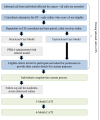Implementing Systematic Screening and Structured Care for Distressed Callers Using Cancer Council's Telephone Services: Protocol for a Randomized Stepped-Wedge Trial
- PMID: 31099341
- PMCID: PMC6542249
- DOI: 10.2196/12473
Implementing Systematic Screening and Structured Care for Distressed Callers Using Cancer Council's Telephone Services: Protocol for a Randomized Stepped-Wedge Trial
Abstract
Background: Structured distress management, comprised a 2-stage screening and referral model, can direct supportive care resources toward individuals who are most likely to benefit. This structured approach has yet to be trialed in Australian community-based services such as Cancer Council New South Wales (NSW) and Victoria Cancer Information and Support (CIS) 13 11 20 lines who care for a large community of cancer patients and caregivers.
Objective: The aim of this study was to evaluate the effectiveness of structured screening and referral in (1) increasing the proportion of distressed CIS callers who accept supportive care referrals and (2) reducing distress levels at 6-month follow-up.
Methods: In this stepped-wedge trial, Cancer Council NSW and Victoria CIS consultants are randomized to deliver structured care during inbound 13 11 20 calls in accordance with 3 intervention periods. Eligible callers are patients or caregivers who score 4 or more on the Distress Thermometer; NSW or Victorian residents; aged 18 years or older; and English proficient. Study data are collected via computer-assisted telephone interviews (CATIs) at 3- and 6-month follow-up and CIS record audit. CATIs include demographic and service use items and the General Health Questionnaire (GHQ-28) to assess distress. An economic analysis of the structured care model will be completed.
Results: The structured care model was developed by guideline review and identification of service characteristics to guide mapping decisions; place-card methodology; and clinical vignettes with think-aloud methodology to confirm referral appropriateness. The model includes an additional screening tool (Patient Health Questionnaire-4) and a referral model with 16-20 CIS services. Descriptive statistics will be used to assess referral uptake rates. Differences between GHQ-28 scores for structured and usual care callers will be tested using a generalized linear mixed model with fixed effects for intervention and each time period. The trial will recruit 1512 callers. The sample size will provide the study with approximately 80% power to detect a difference of 0.3 SD in the mean score of the GHQ-28 at an alpha level of .05 and assuming an intra-cluster correlation of .04. A random sample of recorded calls will be reviewed to assess intervention fidelity and contamination. To date, 1835 distressed callers have been invited to participate with 60.71% (1114/1835) enrolled in the study. A total of 692 participants have completed 6-month CATIs. Recruitment is anticipated to end in late 2019.
Conclusions: This trial is among the first to rigorously test the outcomes of a community-based structured approach to distress management. The model is evidence-informed, practice-ready, and trialed in a real-world setting. The study outcomes will advance the understanding of distress management internationally for both patients and caregivers.
Trial registration: Australian New Zealand Clinical Trial Registry ACTRN12617000352303; https://www.anzctr.org.au/Trial/Registration/TrialReview.aspx?id=372105&isReview=true (Archived by WebCite on http://www.webcitation.org/78AW0Ba09).
International registered report identifier (irrid): DERR1-10.2196/12473.
Keywords: cancer; community health services; psycho-oncology; psychological stress; telephone hotlines.
©Elizabeth A Fradgley, Anna Boltong, Lorna O'Brien, Allison W Boyes, Katherine Lane, Annette Beattie, Tara Clinton-McHarg, Paul B Jacobsen, Christopher Doran, Daniel Barker, Della Roach, Jo Taylor, Christine L Paul. Originally published in JMIR Research Protocols (http://www.researchprotocols.org), 16.05.2019.
Conflict of interest statement
Conflicts of Interest: None declared.
Figures
References
-
- National Comprehensive Cancer Network 2014. [2019-05-06]. NCCN clinical practice guidelines in oncology: distress management (V2) https://www.nccn.org/professionals/physician_gls/pdf/distress.pdf .
-
- Reilly C, Bruner D, Mitchell S, Minasian L, Basch E, Dueck A, Cella D, Reeve B. A literature synthesis of symptom prevalence and severity in persons receiving active cancer treatment. Support Care Cancer. 2013 Jun;21(6):1525–50. doi: 10.1007/s00520-012-1688-0. http://europepmc.org/abstract/MED/23314601 - DOI - PMC - PubMed
-
- Snyder C, Garrett-Mayer E, Brahmer J, Carducci M, Pili R, Stearns V, Wolff A, Dy S, Wu A. Symptoms, supportive care needs, and function in cancer patients: how are they related? Qual Life Res. 2008 Jun;17(5):665–77. doi: 10.1007/s11136-008-9331-8. http://europepmc.org/abstract/MED/18493865 - DOI - PMC - PubMed
-
- Russ T, Stamatakis E, Hamer M, Starr J, Kivimäki M, Batty G. Association between psychological distress and mortality: individual participant pooled analysis of 10 prospective cohort studies. Br Med J. 2012 Jul 31;345:e4933. doi: 10.1136/bmj.e4933. http://europepmc.org/abstract/MED/22849956 - DOI - PMC - PubMed
LinkOut - more resources
Full Text Sources


